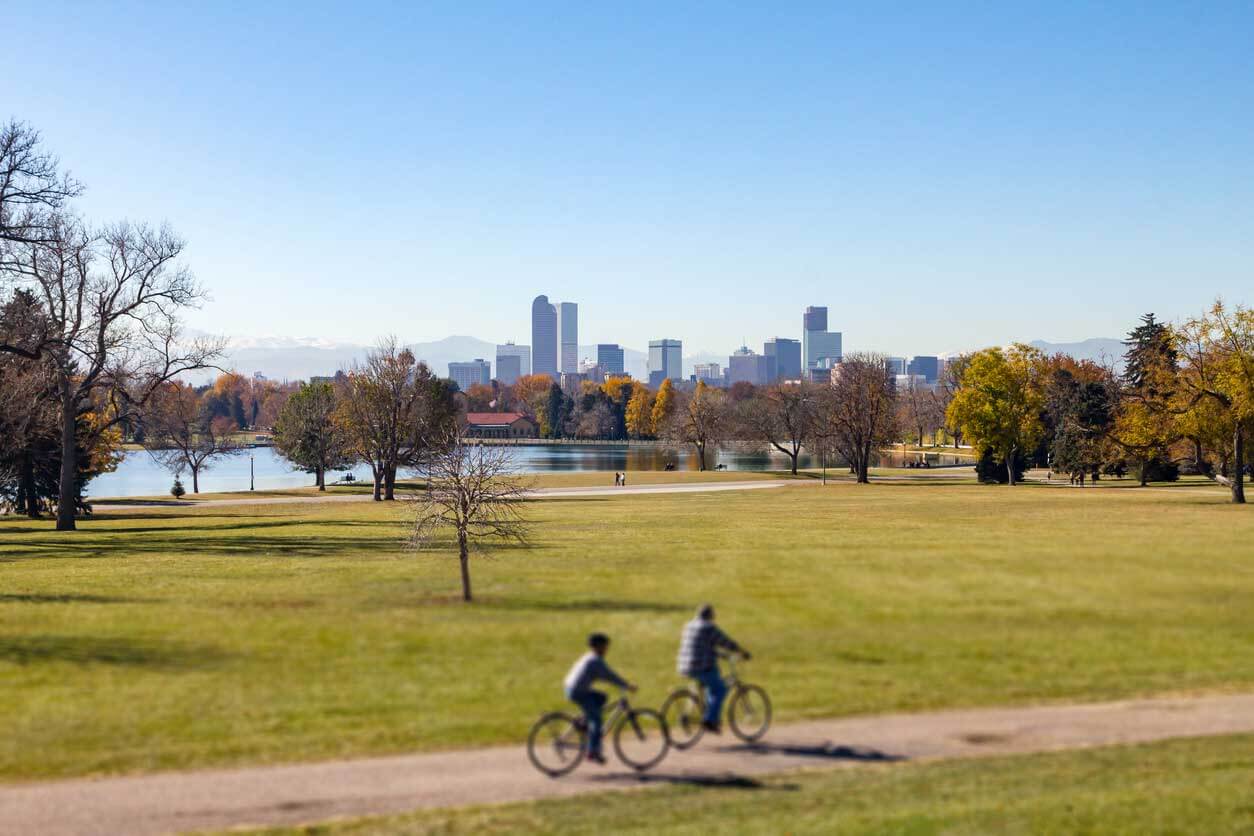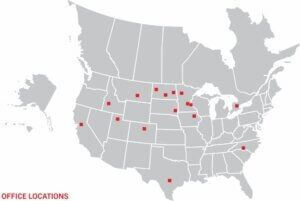How COVID-19 Impacted Bicycle Commuting in Denver

August 24, 2021
Covid-19 has impacted nearly every aspect of our lives. From losing our freedom of movement and reshaping our workplaces to supporting loved ones who are sick, the pandemic is redefining our day-to-day lives in more ways than we ever imagined.
Since the pandemic reached the United States in late February, several researchers and I have been trying to determine how Covid-19 has impacted our transportation systems and what it might mean for transportation in the future. We’ve conducted research and written papers looking at all types of transportation—not just auto routes. “Reference-Free Video-to-Real Distance Approximation-Based Urban Social Distancing Analytics Amid COVID-19 Pandemic” explores walking within a very large city. “Impact of COVID-19 on Bicycle Usage in Colorado Counties” looks at how Covid-19 has impacted the growth of bicycle commuting.
Though this impact varies depending on how different cities and regions have responded to the virus, including length and severity of lockdowns, COVID-19 has certainly affected the use of transportation as it relates to how we gather and move people and goods from one place to another. In addition, the cancellation of daily life events, from family gatherings to concerts, means mass transport is used less. Out of necessity, private modes of transportation are on the rise.
Bicycle Ridership: A Deep Dive
In one study, “Impact of COVID-19 on Bicycle Usage in Colorado Counties,” we looked specifically at one behavior—bicycle ridership. Because bikes are one of the most affordable and naturally socially distant transportation options, bike usage may be preferred by many as an alternative to public transportation.
For our study, we used open data sources and a data-driven machine learning tool to investigate how factors like age, gender, socio-economic level and population density affected bicycle ridership during three periods—before the pandemic, transitioning to the pandemic and during the pandemic.
Our study focused specifically on bicycle ridership in the greater Denver, Colorado, metropolitan area. We were especially interested in the relationship between bicycle usage and socioeconomic factors. To find our results, we considered:
- Continuously collected bicycle count data from four fixed locations in the greater Denver metropolitan area. This data was collected before and after the pandemic to quantify the change in non-motorized traffic volumes.
- The socioeconomic data within the areas surrounding the four locations
- Correlating COVID-19 information
Key Findings
- Initial results showed that average income, average education level and total population have the most impact on behavior. These impacts sometimes shifted based on what stage of the pandemic we were in.
- Regardless of pandemic stage, bike usage increased and public transportation use decreased in areas with higher population density, as people looked for ways to adhere to social distance guidelines and avoid getting infected.
- The location of the COVID-19 pandemic (surges in specific areas of the greater Denver area) had an impact on bicycle demand.
- Post-pandemic bicycle demand is slightly decreasing, but the results of our study show evidence that non-motorized travel modes, specifically cycling, can play a significant role in transportation during nationwide events like a pandemic.
- Currently, as COVID-19 cases start to rise again, bicycle usage may increase again.
- Future work will focus on collecting additional data to cover the whole period of the spread of coronavirus in not only Colorado but also additional locations throughout the country. It will investigate the location-based impact on commuting needs and the long-term impacts of the virus as opposed to the limited duration used in this study.
- As current trends and studies indicate, an increase in bicycle usage due to the COVID-19 pandemic might create an opportunity to increase sustainable transportation. Yet, an in-depth investigation is necessary to be able to understand the extent of this new normal so that the process can be controlled in favor of society.
Future Impact
The Colorado Department of Transportation’s publicly available bicycle count data was critical to our analysis, and it is critical to transportation planning. Having that type of data in the future can help us plan city transportation systems to be more efficient and effective in moving people from one point to another.
While more people are bicycling than ever before, it’s not clear if that trend will continue after the pandemic is over. However, it does create an opportunity for us to re-examine our city transportation systems. More people biking is good for the health of a population, and it’s good for the environment. If another COVID-19 or another airborne virus returns, people will want return to their bikes to maintain a safe distance from others.
Therefore, we should look at opportunities to create more walkable and bikeable cities and neighborhoods. We also should look at the opportunity to build trails and paths that accommodate electric bicycles and scooters, too, which also are increasing in popularity.
If we start designing cities and neighborhoods for more methods of transportation, instead of just cars, we can diversify our use of transportation. This may reduce congestion, reduce the impact on our environment and, in the event of another pandemic, put more people outside where they can safely distance from one another.
Research Details
The work in “Impact of COVID-19 on Bicycle Usage in Colorado Counties,” was sponsored by Ulteig. I conducted this study with:
- Ilgin Gokasar, Ph.D., Associate Professor, Department of Civil Engineering at Bogazici University, Istanbul
- Onur Kalan, Ph.D.
- Alperen Timurogullari, Researcher at Bogazici University
- Burak Altin, student researcher at Bogazici University
As part of our research, we looked at studies conducted in other parts of the world—Beijing, China; New York City; Budapest, Hungary; Oslo, Norway; and Sydney, Australia—on how COVID-19 was affecting behavioral shifts in relation to transportation modes. A growing number of governments are responding to the increase in bicycle ridership by opening emergency bicycle lanes, converting roads into routes for non-motorized traffic, and creating one-way bike lanes in order to comply with social distancing guidelines.
Presentation at TRB’s 100th annual meeting
We’re excited to announce that this research paper, “Impact of COVID-19 on Bicycle Usage in Colorado Counties,” as well as two other transportation-related research papers, have been accepted by the Transportation Research Board (TRB). I will be presenting the findings and research methodology of “Impact of COVID-19 on Bicycle Usage in Colorado Counties” during the TRB 100th Annual Meeting.
If you would like a copy of “Impact of COVID-19 on Bicycle Usage in Colorado Counties,”please contact me at [email protected].
By Abdullah Kurkcu, Ph.D., Lead Traffic Modeler, Ulteig
 Abdullah Kurkcu, Ph.D., is the Lead Traffic Modeler at Ulteig. In his role, Kurkcu works within the Advanced Transportation team at Ulteig. As part of his work, Kurkcu formulates mathematical or simulation models of transportation problems, relating constants and variables, restrictions, alternatives, conflicting objectives and their numerical parameters. He performs validation and testing of models to ensure adequacy and reformulate models as necessary. Kurkcu interprets data from traffic modeling software and incorporate into transportation models, and he applies transportation methods, planning principles, standard industry and new evaluations and analysis to support the planning, engineering, design and implementation of transportation projects for Ulteig’s clients. If you’d like to read more about Kurkcu’s insights about traffic modeling, visit his Medium page.
Abdullah Kurkcu, Ph.D., is the Lead Traffic Modeler at Ulteig. In his role, Kurkcu works within the Advanced Transportation team at Ulteig. As part of his work, Kurkcu formulates mathematical or simulation models of transportation problems, relating constants and variables, restrictions, alternatives, conflicting objectives and their numerical parameters. He performs validation and testing of models to ensure adequacy and reformulate models as necessary. Kurkcu interprets data from traffic modeling software and incorporate into transportation models, and he applies transportation methods, planning principles, standard industry and new evaluations and analysis to support the planning, engineering, design and implementation of transportation projects for Ulteig’s clients. If you’d like to read more about Kurkcu’s insights about traffic modeling, visit his Medium page.
WHAT MAKES ULTEIG DIFFERENT?
From global energy producers to locally funded cities and private developers to government agencies, the clients we serve encompass a broad range of relationships and projects. Find out why Ulteig is a leader in the engineering industry.
Contact Us
